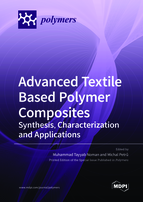Advanced Textile Based Polymer Composites: Synthesis, Characterization and Applications
A special issue of Polymers (ISSN 2073-4360). This special issue belongs to the section "Polymer Composites and Nanocomposites".
Deadline for manuscript submissions: closed (30 December 2022) | Viewed by 40560
Special Issue Editors
Interests: photocatalysis; nanocoating; textile-based composites; polymer composites; materials characterization; surface science; nanofabrication; wastewater treatment
Special Issues, Collections and Topics in MDPI journals
Interests: materials characterization; modeling; optimization; composites; machine design; machine learning
Special Issues, Collections and Topics in MDPI journals
Special Issue Information
Dear Colleagues,
At present, the textile sector is involved in many diversified fields for the development and sustainability of novel products and polymer-based composites, with several challenges present when it comes to producing innovative, novel, and durable materials. The demand for textiles as a reinforcement material for composites has grown exceptionally to promote green chemistry and cost-effectiveness. The fabrication of textiles and polymer-based composites as advanced and multifunctional materials in applied industries is a core fundamental concept of this Special Issue, including textile materials, their structures, surface-treated textiles, nanocoated textiles, mathematical modeling, and the use of artificial intelligence (machine learning) for the prediction of their important parameters, textile materials reinforcement in composites and polymer composites, synthesis, characterization, and applications of textile-based polymer composites for economic and environmental sustainability.
The Special Issue contains the following research topics:
- Synthesis and characterization of functional textiles: Natural, synthetic, blended, etc.;
- Synthesis and characterization of Polymer composites: Natural, synthetic, hybrid, inorganic, etc.;
- Analysis of developed composites: Interfacial, mechanical, thermal, physical, etc.;
- Surface treatment of textile-based polymer composites: Coating, sorption processes. etc.;
- Modelling and simulation of textile-based polymer composites: Artificial intelligence, machine learning, process optimization, statistical analysis, etc.
We invite the authors to submit their research results in the form of full-length articles/review articles on the above-mentioned topics.
Dr. Muhammad Tayyab Noman
Dr. Michal Petrů
Guest Editors
Manuscript Submission Information
Manuscripts should be submitted online at www.mdpi.com by registering and logging in to this website. Once you are registered, click here to go to the submission form. Manuscripts can be submitted until the deadline. All submissions that pass pre-check are peer-reviewed. Accepted papers will be published continuously in the journal (as soon as accepted) and will be listed together on the special issue website. Research articles, review articles as well as short communications are invited. For planned papers, a title and short abstract (about 100 words) can be sent to the Editorial Office for announcement on this website.
Submitted manuscripts should not have been published previously, nor be under consideration for publication elsewhere (except conference proceedings papers). All manuscripts are thoroughly refereed through a single-blind peer-review process. A guide for authors and other relevant information for submission of manuscripts is available on the Instructions for Authors page. Polymers is an international peer-reviewed open access semimonthly journal published by MDPI.
Please visit the Instructions for Authors page before submitting a manuscript. The Article Processing Charge (APC) for publication in this open access journal is 2700 CHF (Swiss Francs). Submitted papers should be well formatted and use good English. Authors may use MDPI's English editing service prior to publication or during author revisions.
Keywords
- Cotton
- Polyester
- Geopolymer
- Nanocoating
- Polymers
- Jute
- Basalt
- Machine learning
- Modeling
- Composites








